BUS707 - Forensic Accounting: Impact on Fraud Detection Research
VerifiedAdded on 2023/06/12
|20
|5136
|316
Report
AI Summary
This research proposal investigates the impact of forensic accounting on fraud detection, addressing the increasing prevalence of financial frauds and their implications for investors and the economy. It aims to understand the methods forensic accounting employs to detect fraud within businesses and define the scope of forensic accounting in curbing financial misrepresentation. The proposal includes a comprehensive literature review, highlighting the application of forensic methods and fraud detection techniques. The research methodology outlines the use of both qualitative and quantitative data, focusing on financial frauds within Australian companies. It also discusses data collection and analysis methods, acknowledging the limitations of the study. The ultimate goal is to contribute to the detection of financial frauds within business systems, thereby reducing financial misrepresentations. Desklib offers a variety of solved assignments and past papers to assist students in their studies.
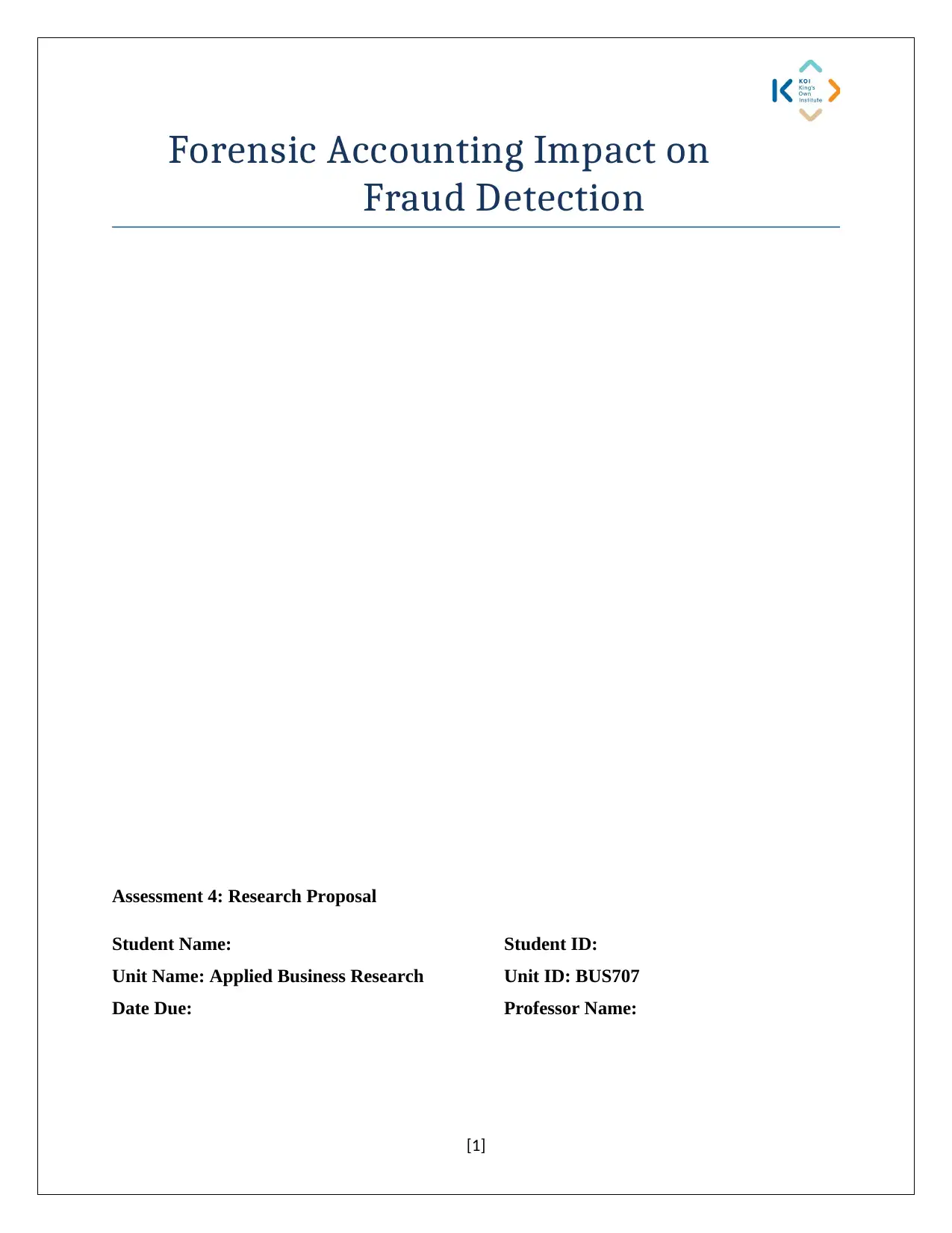
Forensic Accounting Impact on
Fraud Detection
Assessment 4: Research Proposal
Student Name: Student ID:
Unit Name: Applied Business Research Unit ID: BUS707
Date Due: Professor Name:
[1]
Fraud Detection
Assessment 4: Research Proposal
Student Name: Student ID:
Unit Name: Applied Business Research Unit ID: BUS707
Date Due: Professor Name:
[1]
Paraphrase This Document
Need a fresh take? Get an instant paraphrase of this document with our AI Paraphraser
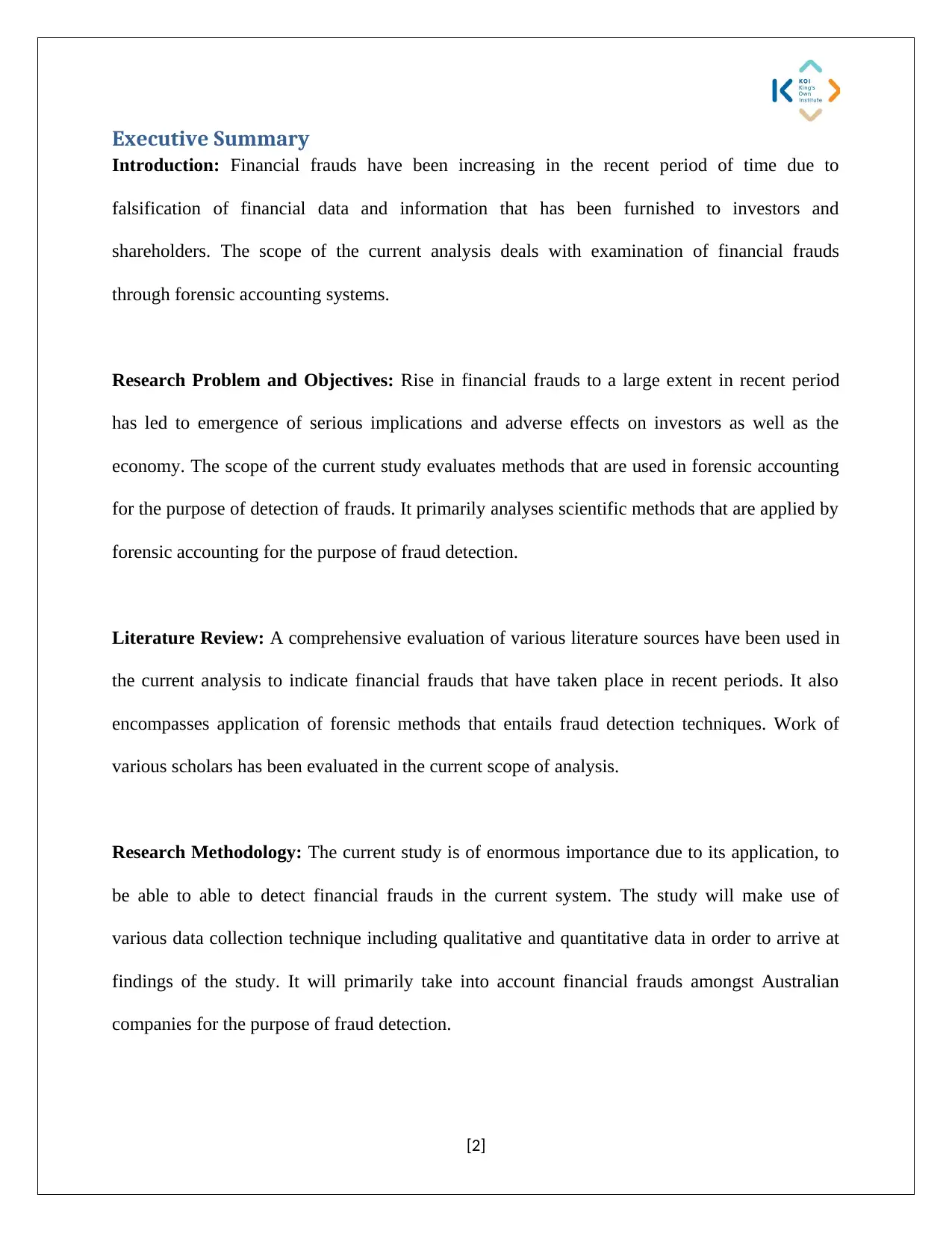
Executive Summary
Introduction: Financial frauds have been increasing in the recent period of time due to
falsification of financial data and information that has been furnished to investors and
shareholders. The scope of the current analysis deals with examination of financial frauds
through forensic accounting systems.
Research Problem and Objectives: Rise in financial frauds to a large extent in recent period
has led to emergence of serious implications and adverse effects on investors as well as the
economy. The scope of the current study evaluates methods that are used in forensic accounting
for the purpose of detection of frauds. It primarily analyses scientific methods that are applied by
forensic accounting for the purpose of fraud detection.
Literature Review: A comprehensive evaluation of various literature sources have been used in
the current analysis to indicate financial frauds that have taken place in recent periods. It also
encompasses application of forensic methods that entails fraud detection techniques. Work of
various scholars has been evaluated in the current scope of analysis.
Research Methodology: The current study is of enormous importance due to its application, to
be able to able to detect financial frauds in the current system. The study will make use of
various data collection technique including qualitative and quantitative data in order to arrive at
findings of the study. It will primarily take into account financial frauds amongst Australian
companies for the purpose of fraud detection.
[2]
Introduction: Financial frauds have been increasing in the recent period of time due to
falsification of financial data and information that has been furnished to investors and
shareholders. The scope of the current analysis deals with examination of financial frauds
through forensic accounting systems.
Research Problem and Objectives: Rise in financial frauds to a large extent in recent period
has led to emergence of serious implications and adverse effects on investors as well as the
economy. The scope of the current study evaluates methods that are used in forensic accounting
for the purpose of detection of frauds. It primarily analyses scientific methods that are applied by
forensic accounting for the purpose of fraud detection.
Literature Review: A comprehensive evaluation of various literature sources have been used in
the current analysis to indicate financial frauds that have taken place in recent periods. It also
encompasses application of forensic methods that entails fraud detection techniques. Work of
various scholars has been evaluated in the current scope of analysis.
Research Methodology: The current study is of enormous importance due to its application, to
be able to able to detect financial frauds in the current system. The study will make use of
various data collection technique including qualitative and quantitative data in order to arrive at
findings of the study. It will primarily take into account financial frauds amongst Australian
companies for the purpose of fraud detection.
[2]
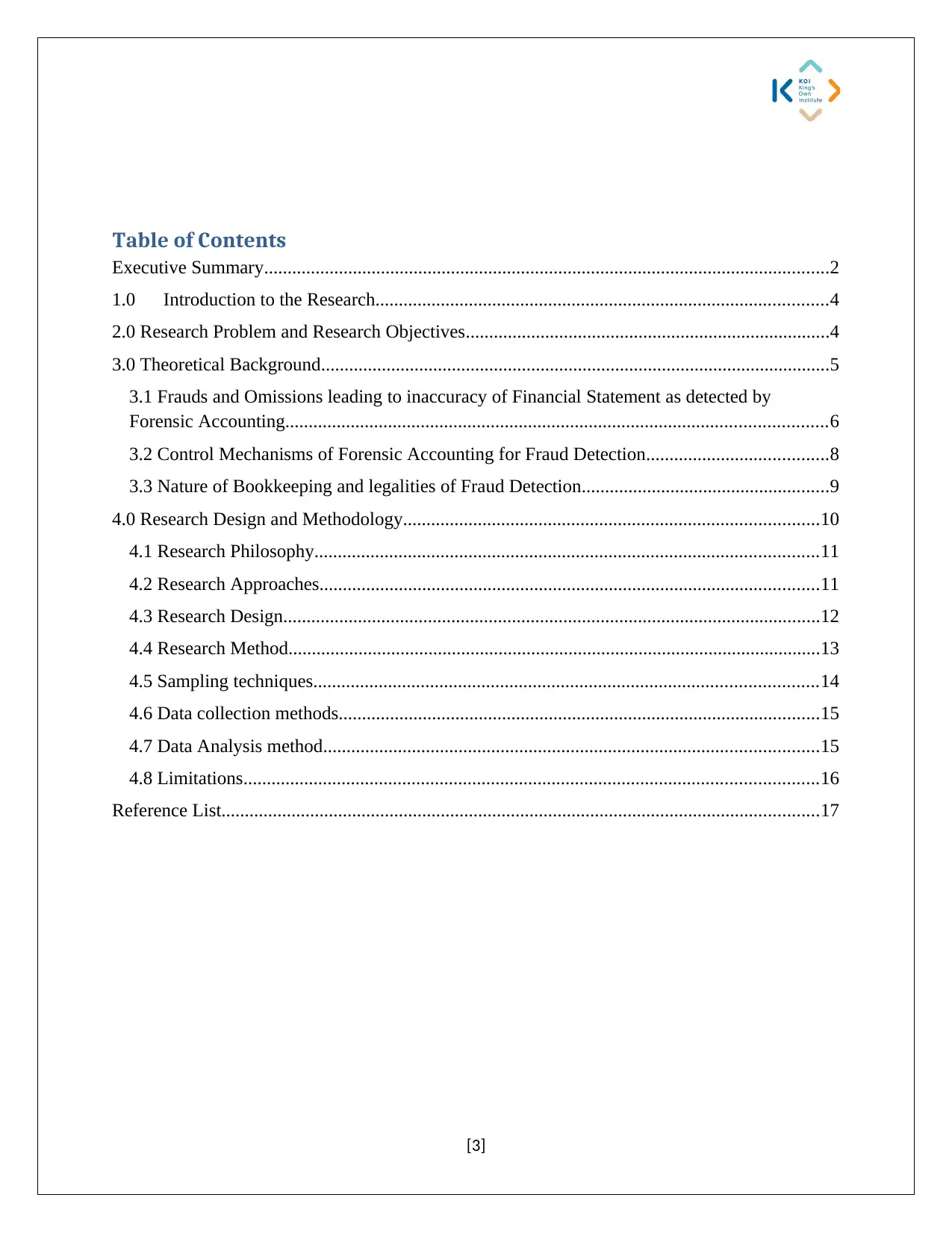
Table of Contents
Executive Summary.........................................................................................................................2
1.0 Introduction to the Research.................................................................................................4
2.0 Research Problem and Research Objectives..............................................................................4
3.0 Theoretical Background.............................................................................................................5
3.1 Frauds and Omissions leading to inaccuracy of Financial Statement as detected by
Forensic Accounting....................................................................................................................6
3.2 Control Mechanisms of Forensic Accounting for Fraud Detection.......................................8
3.3 Nature of Bookkeeping and legalities of Fraud Detection.....................................................9
4.0 Research Design and Methodology.........................................................................................10
4.1 Research Philosophy............................................................................................................11
4.2 Research Approaches...........................................................................................................11
4.3 Research Design...................................................................................................................12
4.4 Research Method..................................................................................................................13
4.5 Sampling techniques............................................................................................................14
4.6 Data collection methods.......................................................................................................15
4.7 Data Analysis method..........................................................................................................15
4.8 Limitations...........................................................................................................................16
Reference List................................................................................................................................17
[3]
Executive Summary.........................................................................................................................2
1.0 Introduction to the Research.................................................................................................4
2.0 Research Problem and Research Objectives..............................................................................4
3.0 Theoretical Background.............................................................................................................5
3.1 Frauds and Omissions leading to inaccuracy of Financial Statement as detected by
Forensic Accounting....................................................................................................................6
3.2 Control Mechanisms of Forensic Accounting for Fraud Detection.......................................8
3.3 Nature of Bookkeeping and legalities of Fraud Detection.....................................................9
4.0 Research Design and Methodology.........................................................................................10
4.1 Research Philosophy............................................................................................................11
4.2 Research Approaches...........................................................................................................11
4.3 Research Design...................................................................................................................12
4.4 Research Method..................................................................................................................13
4.5 Sampling techniques............................................................................................................14
4.6 Data collection methods.......................................................................................................15
4.7 Data Analysis method..........................................................................................................15
4.8 Limitations...........................................................................................................................16
Reference List................................................................................................................................17
[3]
⊘ This is a preview!⊘
Do you want full access?
Subscribe today to unlock all pages.

Trusted by 1+ million students worldwide
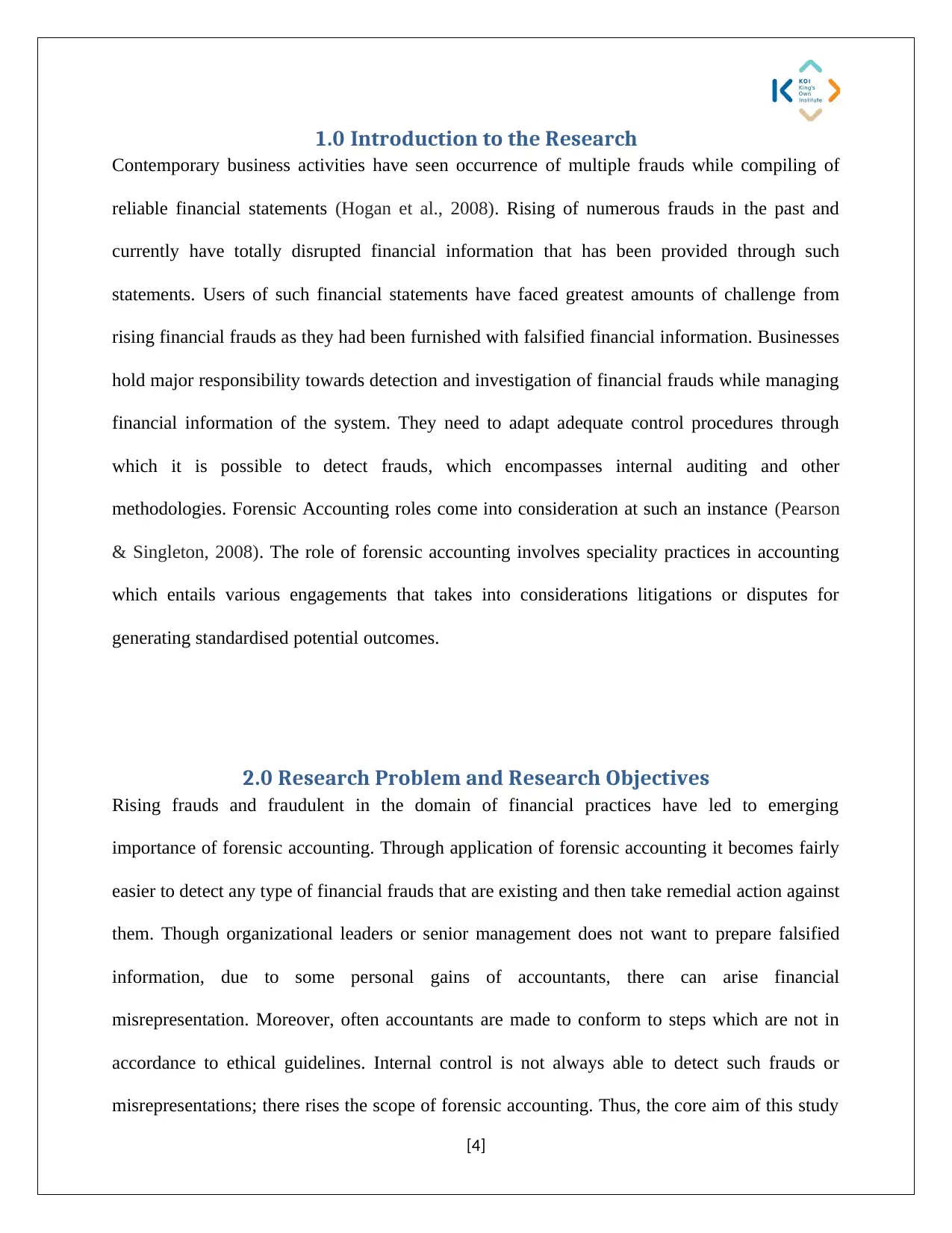
1.0 Introduction to the Research
Contemporary business activities have seen occurrence of multiple frauds while compiling of
reliable financial statements (Hogan et al., 2008). Rising of numerous frauds in the past and
currently have totally disrupted financial information that has been provided through such
statements. Users of such financial statements have faced greatest amounts of challenge from
rising financial frauds as they had been furnished with falsified financial information. Businesses
hold major responsibility towards detection and investigation of financial frauds while managing
financial information of the system. They need to adapt adequate control procedures through
which it is possible to detect frauds, which encompasses internal auditing and other
methodologies. Forensic Accounting roles come into consideration at such an instance (Pearson
& Singleton, 2008). The role of forensic accounting involves speciality practices in accounting
which entails various engagements that takes into considerations litigations or disputes for
generating standardised potential outcomes.
2.0 Research Problem and Research Objectives
Rising frauds and fraudulent in the domain of financial practices have led to emerging
importance of forensic accounting. Through application of forensic accounting it becomes fairly
easier to detect any type of financial frauds that are existing and then take remedial action against
them. Though organizational leaders or senior management does not want to prepare falsified
information, due to some personal gains of accountants, there can arise financial
misrepresentation. Moreover, often accountants are made to conform to steps which are not in
accordance to ethical guidelines. Internal control is not always able to detect such frauds or
misrepresentations; there rises the scope of forensic accounting. Thus, the core aim of this study
[4]
Contemporary business activities have seen occurrence of multiple frauds while compiling of
reliable financial statements (Hogan et al., 2008). Rising of numerous frauds in the past and
currently have totally disrupted financial information that has been provided through such
statements. Users of such financial statements have faced greatest amounts of challenge from
rising financial frauds as they had been furnished with falsified financial information. Businesses
hold major responsibility towards detection and investigation of financial frauds while managing
financial information of the system. They need to adapt adequate control procedures through
which it is possible to detect frauds, which encompasses internal auditing and other
methodologies. Forensic Accounting roles come into consideration at such an instance (Pearson
& Singleton, 2008). The role of forensic accounting involves speciality practices in accounting
which entails various engagements that takes into considerations litigations or disputes for
generating standardised potential outcomes.
2.0 Research Problem and Research Objectives
Rising frauds and fraudulent in the domain of financial practices have led to emerging
importance of forensic accounting. Through application of forensic accounting it becomes fairly
easier to detect any type of financial frauds that are existing and then take remedial action against
them. Though organizational leaders or senior management does not want to prepare falsified
information, due to some personal gains of accountants, there can arise financial
misrepresentation. Moreover, often accountants are made to conform to steps which are not in
accordance to ethical guidelines. Internal control is not always able to detect such frauds or
misrepresentations; there rises the scope of forensic accounting. Thus, the core aim of this study
[4]
Paraphrase This Document
Need a fresh take? Get an instant paraphrase of this document with our AI Paraphraser
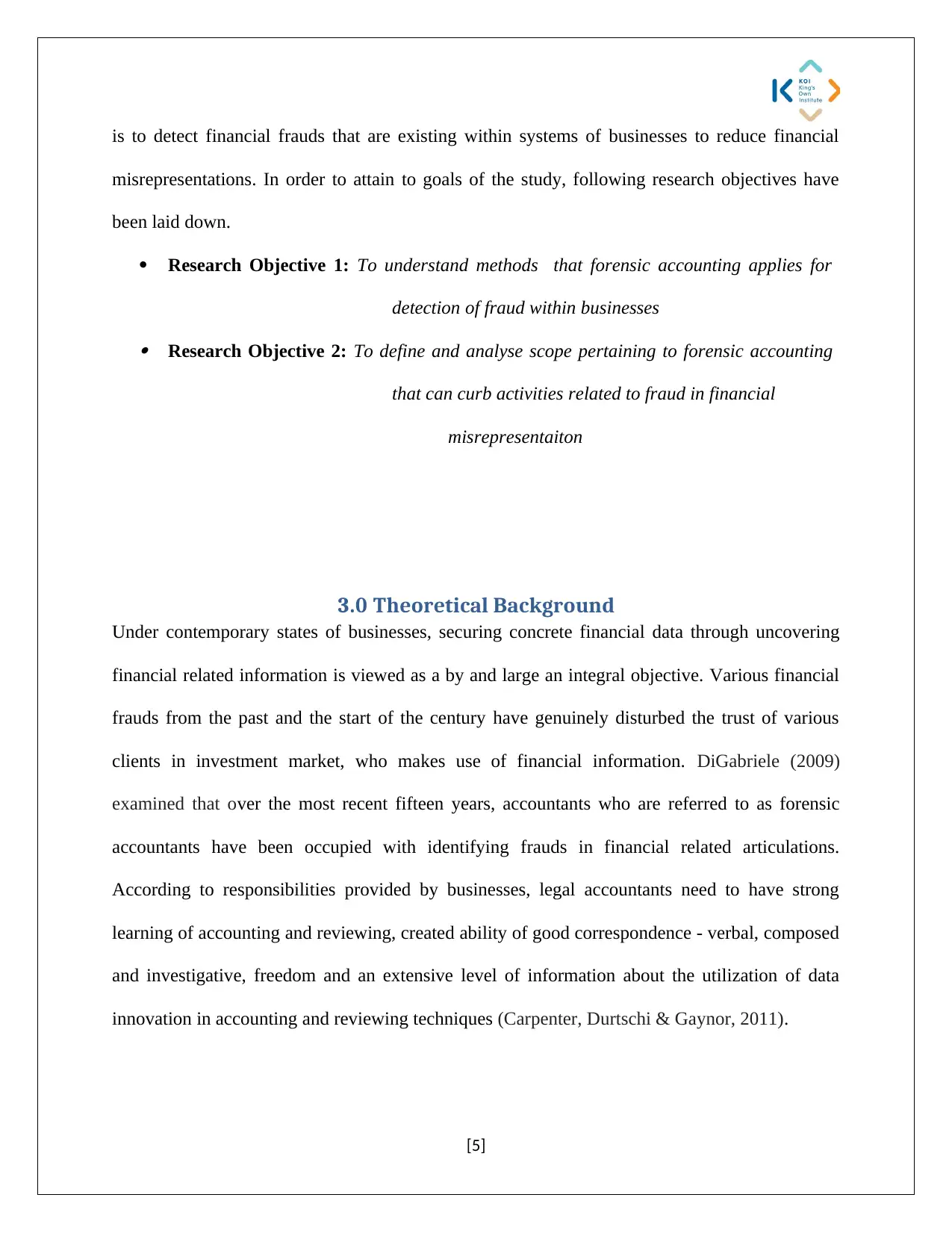
is to detect financial frauds that are existing within systems of businesses to reduce financial
misrepresentations. In order to attain to goals of the study, following research objectives have
been laid down.
Research Objective 1: To understand methods that forensic accounting applies for
detection of fraud within businesses Research Objective 2: To define and analyse scope pertaining to forensic accounting
that can curb activities related to fraud in financial
misrepresentaiton
3.0 Theoretical Background
Under contemporary states of businesses, securing concrete financial data through uncovering
financial related information is viewed as a by and large an integral objective. Various financial
frauds from the past and the start of the century have genuinely disturbed the trust of various
clients in investment market, who makes use of financial information. DiGabriele (2009)
examined that over the most recent fifteen years, accountants who are referred to as forensic
accountants have been occupied with identifying frauds in financial related articulations.
According to responsibilities provided by businesses, legal accountants need to have strong
learning of accounting and reviewing, created ability of good correspondence - verbal, composed
and investigative, freedom and an extensive level of information about the utilization of data
innovation in accounting and reviewing techniques (Carpenter, Durtschi & Gaynor, 2011).
[5]
misrepresentations. In order to attain to goals of the study, following research objectives have
been laid down.
Research Objective 1: To understand methods that forensic accounting applies for
detection of fraud within businesses Research Objective 2: To define and analyse scope pertaining to forensic accounting
that can curb activities related to fraud in financial
misrepresentaiton
3.0 Theoretical Background
Under contemporary states of businesses, securing concrete financial data through uncovering
financial related information is viewed as a by and large an integral objective. Various financial
frauds from the past and the start of the century have genuinely disturbed the trust of various
clients in investment market, who makes use of financial information. DiGabriele (2009)
examined that over the most recent fifteen years, accountants who are referred to as forensic
accountants have been occupied with identifying frauds in financial related articulations.
According to responsibilities provided by businesses, legal accountants need to have strong
learning of accounting and reviewing, created ability of good correspondence - verbal, composed
and investigative, freedom and an extensive level of information about the utilization of data
innovation in accounting and reviewing techniques (Carpenter, Durtschi & Gaynor, 2011).
[5]
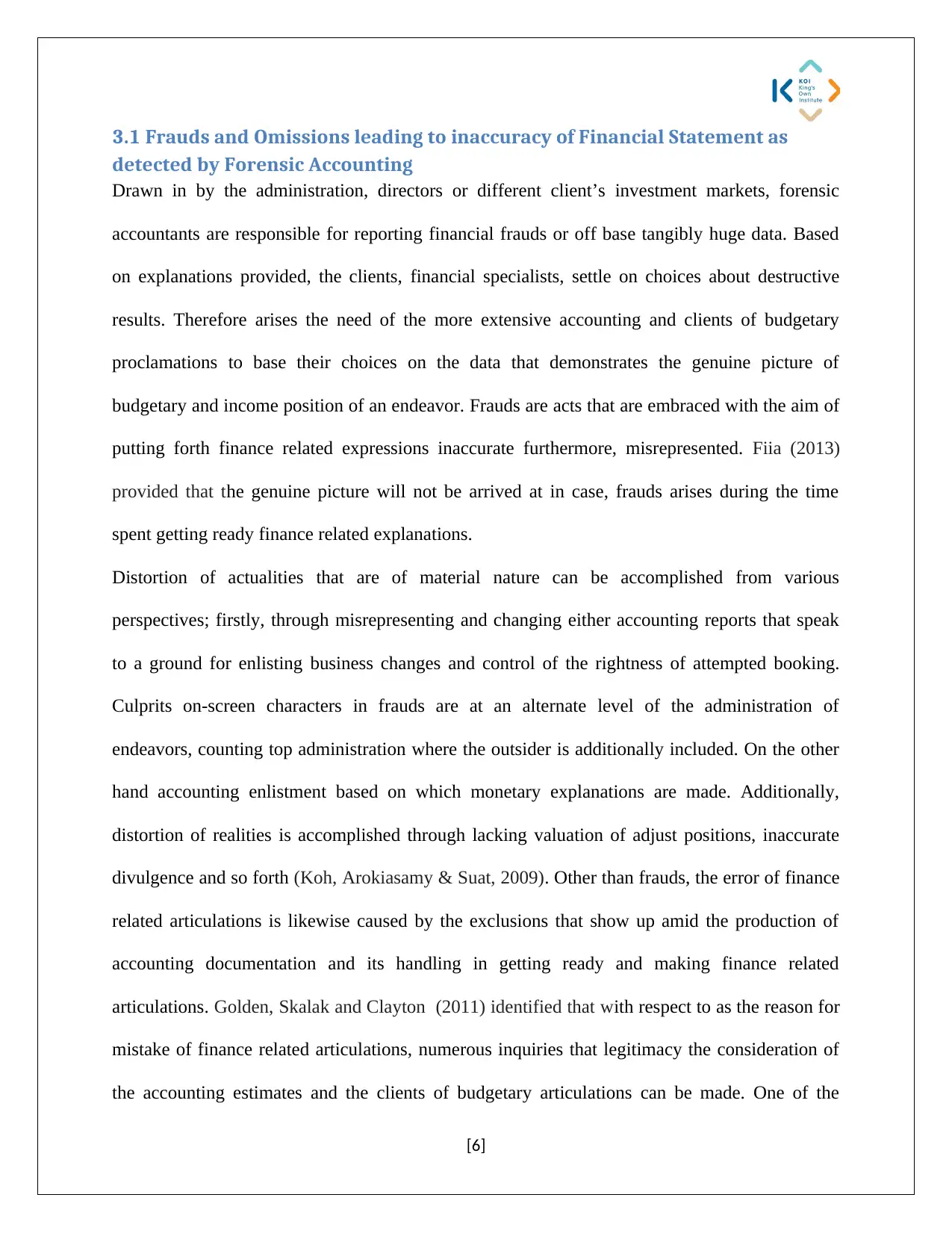
3.1 Frauds and Omissions leading to inaccuracy of Financial Statement as
detected by Forensic Accounting
Drawn in by the administration, directors or different client’s investment markets, forensic
accountants are responsible for reporting financial frauds or off base tangibly huge data. Based
on explanations provided, the clients, financial specialists, settle on choices about destructive
results. Therefore arises the need of the more extensive accounting and clients of budgetary
proclamations to base their choices on the data that demonstrates the genuine picture of
budgetary and income position of an endeavor. Frauds are acts that are embraced with the aim of
putting forth finance related expressions inaccurate furthermore, misrepresented. Fiia (2013)
provided that the genuine picture will not be arrived at in case, frauds arises during the time
spent getting ready finance related explanations.
Distortion of actualities that are of material nature can be accomplished from various
perspectives; firstly, through misrepresenting and changing either accounting reports that speak
to a ground for enlisting business changes and control of the rightness of attempted booking.
Culprits on-screen characters in frauds are at an alternate level of the administration of
endeavors, counting top administration where the outsider is additionally included. On the other
hand accounting enlistment based on which monetary explanations are made. Additionally,
distortion of realities is accomplished through lacking valuation of adjust positions, inaccurate
divulgence and so forth (Koh, Arokiasamy & Suat, 2009). Other than frauds, the error of finance
related articulations is likewise caused by the exclusions that show up amid the production of
accounting documentation and its handling in getting ready and making finance related
articulations. Golden, Skalak and Clayton (2011) identified that with respect to as the reason for
mistake of finance related articulations, numerous inquiries that legitimacy the consideration of
the accounting estimates and the clients of budgetary articulations can be made. One of the
[6]
detected by Forensic Accounting
Drawn in by the administration, directors or different client’s investment markets, forensic
accountants are responsible for reporting financial frauds or off base tangibly huge data. Based
on explanations provided, the clients, financial specialists, settle on choices about destructive
results. Therefore arises the need of the more extensive accounting and clients of budgetary
proclamations to base their choices on the data that demonstrates the genuine picture of
budgetary and income position of an endeavor. Frauds are acts that are embraced with the aim of
putting forth finance related expressions inaccurate furthermore, misrepresented. Fiia (2013)
provided that the genuine picture will not be arrived at in case, frauds arises during the time
spent getting ready finance related explanations.
Distortion of actualities that are of material nature can be accomplished from various
perspectives; firstly, through misrepresenting and changing either accounting reports that speak
to a ground for enlisting business changes and control of the rightness of attempted booking.
Culprits on-screen characters in frauds are at an alternate level of the administration of
endeavors, counting top administration where the outsider is additionally included. On the other
hand accounting enlistment based on which monetary explanations are made. Additionally,
distortion of realities is accomplished through lacking valuation of adjust positions, inaccurate
divulgence and so forth (Koh, Arokiasamy & Suat, 2009). Other than frauds, the error of finance
related articulations is likewise caused by the exclusions that show up amid the production of
accounting documentation and its handling in getting ready and making finance related
articulations. Golden, Skalak and Clayton (2011) identified that with respect to as the reason for
mistake of finance related articulations, numerous inquiries that legitimacy the consideration of
the accounting estimates and the clients of budgetary articulations can be made. One of the
[6]
⊘ This is a preview!⊘
Do you want full access?
Subscribe today to unlock all pages.

Trusted by 1+ million students worldwide
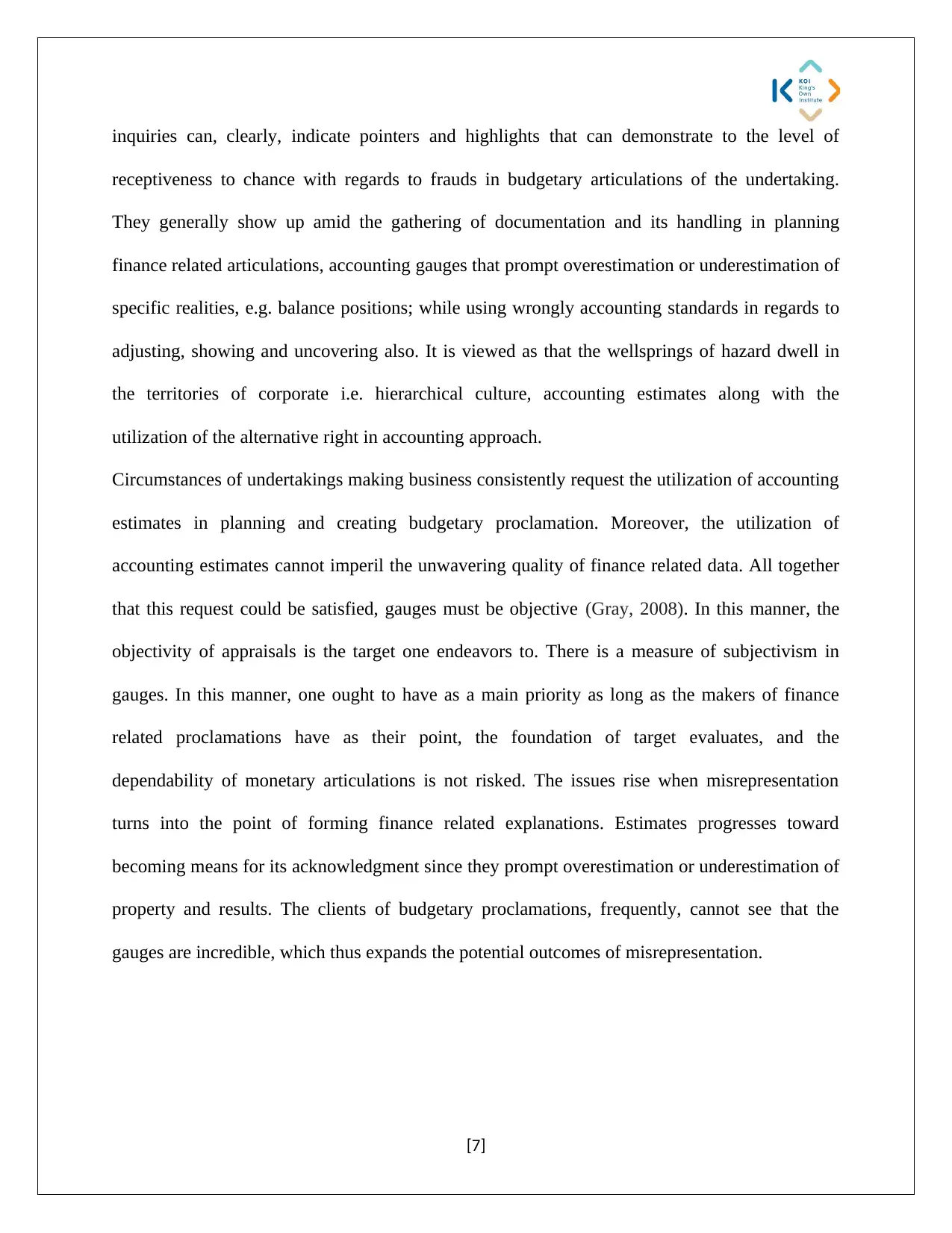
inquiries can, clearly, indicate pointers and highlights that can demonstrate to the level of
receptiveness to chance with regards to frauds in budgetary articulations of the undertaking.
They generally show up amid the gathering of documentation and its handling in planning
finance related articulations, accounting gauges that prompt overestimation or underestimation of
specific realities, e.g. balance positions; while using wrongly accounting standards in regards to
adjusting, showing and uncovering also. It is viewed as that the wellsprings of hazard dwell in
the territories of corporate i.e. hierarchical culture, accounting estimates along with the
utilization of the alternative right in accounting approach.
Circumstances of undertakings making business consistently request the utilization of accounting
estimates in planning and creating budgetary proclamation. Moreover, the utilization of
accounting estimates cannot imperil the unwavering quality of finance related data. All together
that this request could be satisfied, gauges must be objective (Gray, 2008). In this manner, the
objectivity of appraisals is the target one endeavors to. There is a measure of subjectivism in
gauges. In this manner, one ought to have as a main priority as long as the makers of finance
related proclamations have as their point, the foundation of target evaluates, and the
dependability of monetary articulations is not risked. The issues rise when misrepresentation
turns into the point of forming finance related explanations. Estimates progresses toward
becoming means for its acknowledgment since they prompt overestimation or underestimation of
property and results. The clients of budgetary proclamations, frequently, cannot see that the
gauges are incredible, which thus expands the potential outcomes of misrepresentation.
[7]
receptiveness to chance with regards to frauds in budgetary articulations of the undertaking.
They generally show up amid the gathering of documentation and its handling in planning
finance related articulations, accounting gauges that prompt overestimation or underestimation of
specific realities, e.g. balance positions; while using wrongly accounting standards in regards to
adjusting, showing and uncovering also. It is viewed as that the wellsprings of hazard dwell in
the territories of corporate i.e. hierarchical culture, accounting estimates along with the
utilization of the alternative right in accounting approach.
Circumstances of undertakings making business consistently request the utilization of accounting
estimates in planning and creating budgetary proclamation. Moreover, the utilization of
accounting estimates cannot imperil the unwavering quality of finance related data. All together
that this request could be satisfied, gauges must be objective (Gray, 2008). In this manner, the
objectivity of appraisals is the target one endeavors to. There is a measure of subjectivism in
gauges. In this manner, one ought to have as a main priority as long as the makers of finance
related proclamations have as their point, the foundation of target evaluates, and the
dependability of monetary articulations is not risked. The issues rise when misrepresentation
turns into the point of forming finance related explanations. Estimates progresses toward
becoming means for its acknowledgment since they prompt overestimation or underestimation of
property and results. The clients of budgetary proclamations, frequently, cannot see that the
gauges are incredible, which thus expands the potential outcomes of misrepresentation.
[7]
Paraphrase This Document
Need a fresh take? Get an instant paraphrase of this document with our AI Paraphraser
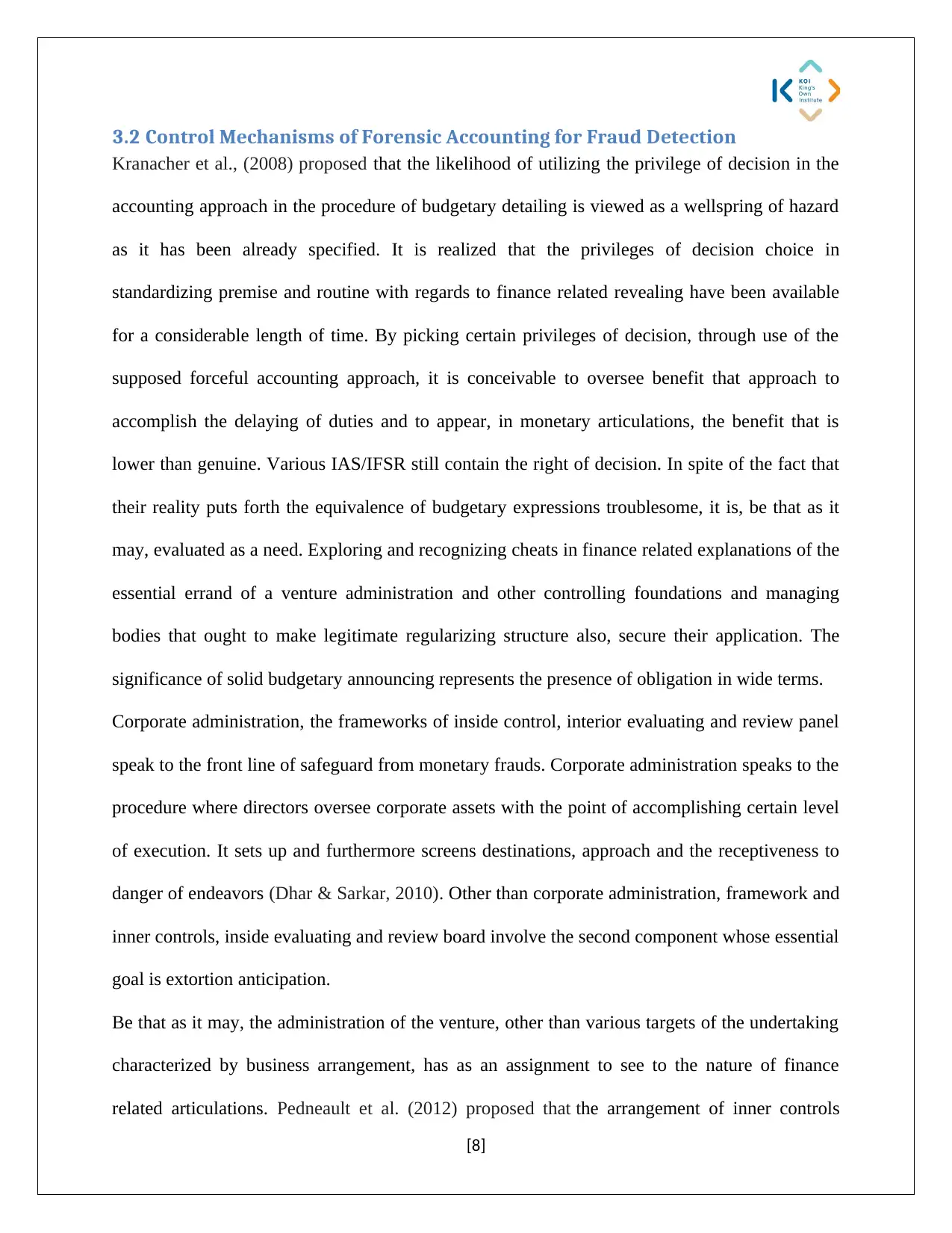
3.2 Control Mechanisms of Forensic Accounting for Fraud Detection
Kranacher et al., (2008) proposed that the likelihood of utilizing the privilege of decision in the
accounting approach in the procedure of budgetary detailing is viewed as a wellspring of hazard
as it has been already specified. It is realized that the privileges of decision choice in
standardizing premise and routine with regards to finance related revealing have been available
for a considerable length of time. By picking certain privileges of decision, through use of the
supposed forceful accounting approach, it is conceivable to oversee benefit that approach to
accomplish the delaying of duties and to appear, in monetary articulations, the benefit that is
lower than genuine. Various IAS/IFSR still contain the right of decision. In spite of the fact that
their reality puts forth the equivalence of budgetary expressions troublesome, it is, be that as it
may, evaluated as a need. Exploring and recognizing cheats in finance related explanations of the
essential errand of a venture administration and other controlling foundations and managing
bodies that ought to make legitimate regularizing structure also, secure their application. The
significance of solid budgetary announcing represents the presence of obligation in wide terms.
Corporate administration, the frameworks of inside control, interior evaluating and review panel
speak to the front line of safeguard from monetary frauds. Corporate administration speaks to the
procedure where directors oversee corporate assets with the point of accomplishing certain level
of execution. It sets up and furthermore screens destinations, approach and the receptiveness to
danger of endeavors (Dhar & Sarkar, 2010). Other than corporate administration, framework and
inner controls, inside evaluating and review board involve the second component whose essential
goal is extortion anticipation.
Be that as it may, the administration of the venture, other than various targets of the undertaking
characterized by business arrangement, has as an assignment to see to the nature of finance
related articulations. Pedneault et al. (2012) proposed that the arrangement of inner controls
[8]
Kranacher et al., (2008) proposed that the likelihood of utilizing the privilege of decision in the
accounting approach in the procedure of budgetary detailing is viewed as a wellspring of hazard
as it has been already specified. It is realized that the privileges of decision choice in
standardizing premise and routine with regards to finance related revealing have been available
for a considerable length of time. By picking certain privileges of decision, through use of the
supposed forceful accounting approach, it is conceivable to oversee benefit that approach to
accomplish the delaying of duties and to appear, in monetary articulations, the benefit that is
lower than genuine. Various IAS/IFSR still contain the right of decision. In spite of the fact that
their reality puts forth the equivalence of budgetary expressions troublesome, it is, be that as it
may, evaluated as a need. Exploring and recognizing cheats in finance related explanations of the
essential errand of a venture administration and other controlling foundations and managing
bodies that ought to make legitimate regularizing structure also, secure their application. The
significance of solid budgetary announcing represents the presence of obligation in wide terms.
Corporate administration, the frameworks of inside control, interior evaluating and review panel
speak to the front line of safeguard from monetary frauds. Corporate administration speaks to the
procedure where directors oversee corporate assets with the point of accomplishing certain level
of execution. It sets up and furthermore screens destinations, approach and the receptiveness to
danger of endeavors (Dhar & Sarkar, 2010). Other than corporate administration, framework and
inner controls, inside evaluating and review board involve the second component whose essential
goal is extortion anticipation.
Be that as it may, the administration of the venture, other than various targets of the undertaking
characterized by business arrangement, has as an assignment to see to the nature of finance
related articulations. Pedneault et al. (2012) proposed that the arrangement of inner controls
[8]
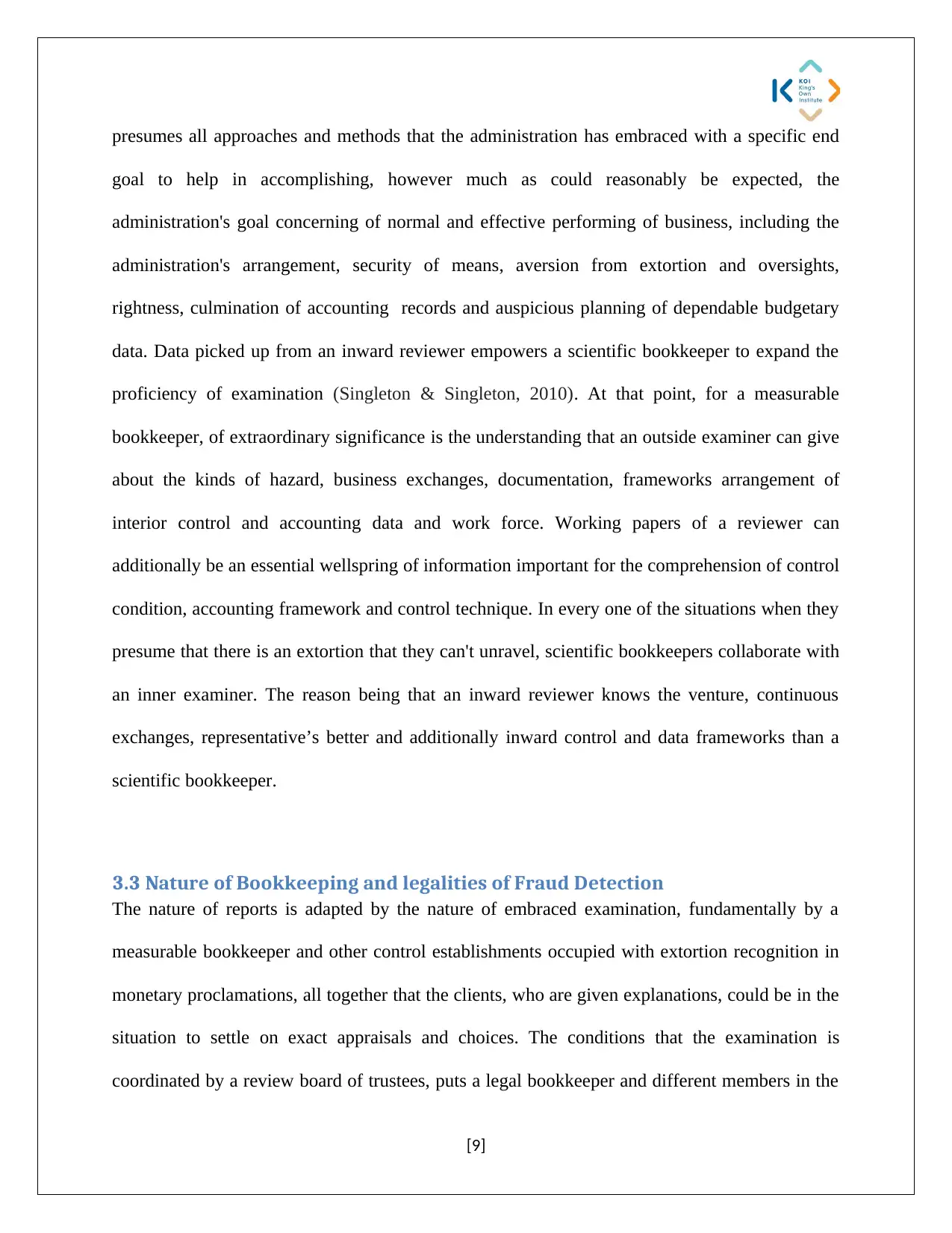
presumes all approaches and methods that the administration has embraced with a specific end
goal to help in accomplishing, however much as could reasonably be expected, the
administration's goal concerning of normal and effective performing of business, including the
administration's arrangement, security of means, aversion from extortion and oversights,
rightness, culmination of accounting records and auspicious planning of dependable budgetary
data. Data picked up from an inward reviewer empowers a scientific bookkeeper to expand the
proficiency of examination (Singleton & Singleton, 2010). At that point, for a measurable
bookkeeper, of extraordinary significance is the understanding that an outside examiner can give
about the kinds of hazard, business exchanges, documentation, frameworks arrangement of
interior control and accounting data and work force. Working papers of a reviewer can
additionally be an essential wellspring of information important for the comprehension of control
condition, accounting framework and control technique. In every one of the situations when they
presume that there is an extortion that they can't unravel, scientific bookkeepers collaborate with
an inner examiner. The reason being that an inward reviewer knows the venture, continuous
exchanges, representative’s better and additionally inward control and data frameworks than a
scientific bookkeeper.
3.3 Nature of Bookkeeping and legalities of Fraud Detection
The nature of reports is adapted by the nature of embraced examination, fundamentally by a
measurable bookkeeper and other control establishments occupied with extortion recognition in
monetary proclamations, all together that the clients, who are given explanations, could be in the
situation to settle on exact appraisals and choices. The conditions that the examination is
coordinated by a review board of trustees, puts a legal bookkeeper and different members in the
[9]
goal to help in accomplishing, however much as could reasonably be expected, the
administration's goal concerning of normal and effective performing of business, including the
administration's arrangement, security of means, aversion from extortion and oversights,
rightness, culmination of accounting records and auspicious planning of dependable budgetary
data. Data picked up from an inward reviewer empowers a scientific bookkeeper to expand the
proficiency of examination (Singleton & Singleton, 2010). At that point, for a measurable
bookkeeper, of extraordinary significance is the understanding that an outside examiner can give
about the kinds of hazard, business exchanges, documentation, frameworks arrangement of
interior control and accounting data and work force. Working papers of a reviewer can
additionally be an essential wellspring of information important for the comprehension of control
condition, accounting framework and control technique. In every one of the situations when they
presume that there is an extortion that they can't unravel, scientific bookkeepers collaborate with
an inner examiner. The reason being that an inward reviewer knows the venture, continuous
exchanges, representative’s better and additionally inward control and data frameworks than a
scientific bookkeeper.
3.3 Nature of Bookkeeping and legalities of Fraud Detection
The nature of reports is adapted by the nature of embraced examination, fundamentally by a
measurable bookkeeper and other control establishments occupied with extortion recognition in
monetary proclamations, all together that the clients, who are given explanations, could be in the
situation to settle on exact appraisals and choices. The conditions that the examination is
coordinated by a review board of trustees, puts a legal bookkeeper and different members in the
[9]
⊘ This is a preview!⊘
Do you want full access?
Subscribe today to unlock all pages.

Trusted by 1+ million students worldwide
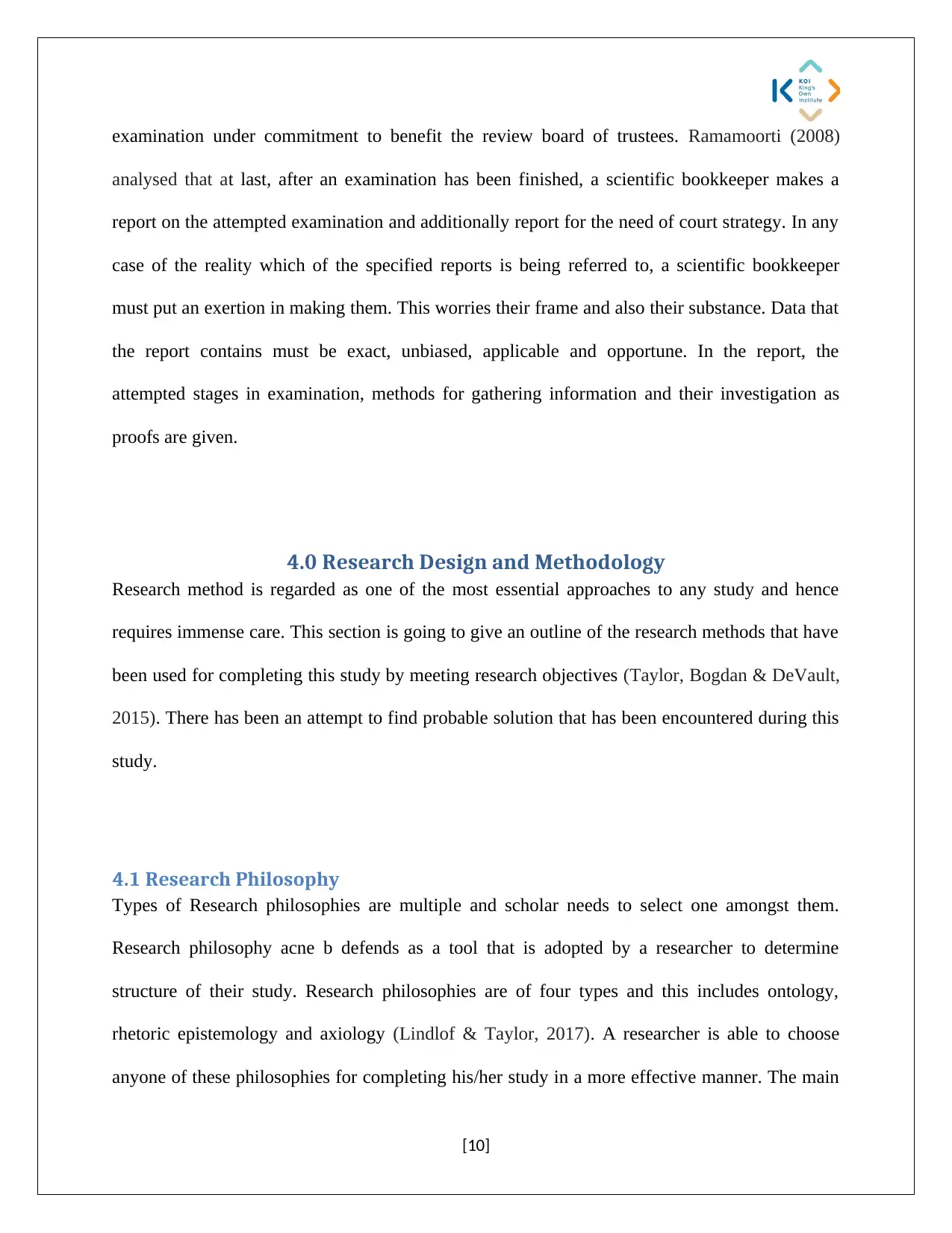
examination under commitment to benefit the review board of trustees. Ramamoorti (2008)
analysed that at last, after an examination has been finished, a scientific bookkeeper makes a
report on the attempted examination and additionally report for the need of court strategy. In any
case of the reality which of the specified reports is being referred to, a scientific bookkeeper
must put an exertion in making them. This worries their frame and also their substance. Data that
the report contains must be exact, unbiased, applicable and opportune. In the report, the
attempted stages in examination, methods for gathering information and their investigation as
proofs are given.
4.0 Research Design and Methodology
Research method is regarded as one of the most essential approaches to any study and hence
requires immense care. This section is going to give an outline of the research methods that have
been used for completing this study by meeting research objectives (Taylor, Bogdan & DeVault,
2015). There has been an attempt to find probable solution that has been encountered during this
study.
4.1 Research Philosophy
Types of Research philosophies are multiple and scholar needs to select one amongst them.
Research philosophy acne b defends as a tool that is adopted by a researcher to determine
structure of their study. Research philosophies are of four types and this includes ontology,
rhetoric epistemology and axiology (Lindlof & Taylor, 2017). A researcher is able to choose
anyone of these philosophies for completing his/her study in a more effective manner. The main
[10]
analysed that at last, after an examination has been finished, a scientific bookkeeper makes a
report on the attempted examination and additionally report for the need of court strategy. In any
case of the reality which of the specified reports is being referred to, a scientific bookkeeper
must put an exertion in making them. This worries their frame and also their substance. Data that
the report contains must be exact, unbiased, applicable and opportune. In the report, the
attempted stages in examination, methods for gathering information and their investigation as
proofs are given.
4.0 Research Design and Methodology
Research method is regarded as one of the most essential approaches to any study and hence
requires immense care. This section is going to give an outline of the research methods that have
been used for completing this study by meeting research objectives (Taylor, Bogdan & DeVault,
2015). There has been an attempt to find probable solution that has been encountered during this
study.
4.1 Research Philosophy
Types of Research philosophies are multiple and scholar needs to select one amongst them.
Research philosophy acne b defends as a tool that is adopted by a researcher to determine
structure of their study. Research philosophies are of four types and this includes ontology,
rhetoric epistemology and axiology (Lindlof & Taylor, 2017). A researcher is able to choose
anyone of these philosophies for completing his/her study in a more effective manner. The main
[10]
Paraphrase This Document
Need a fresh take? Get an instant paraphrase of this document with our AI Paraphraser
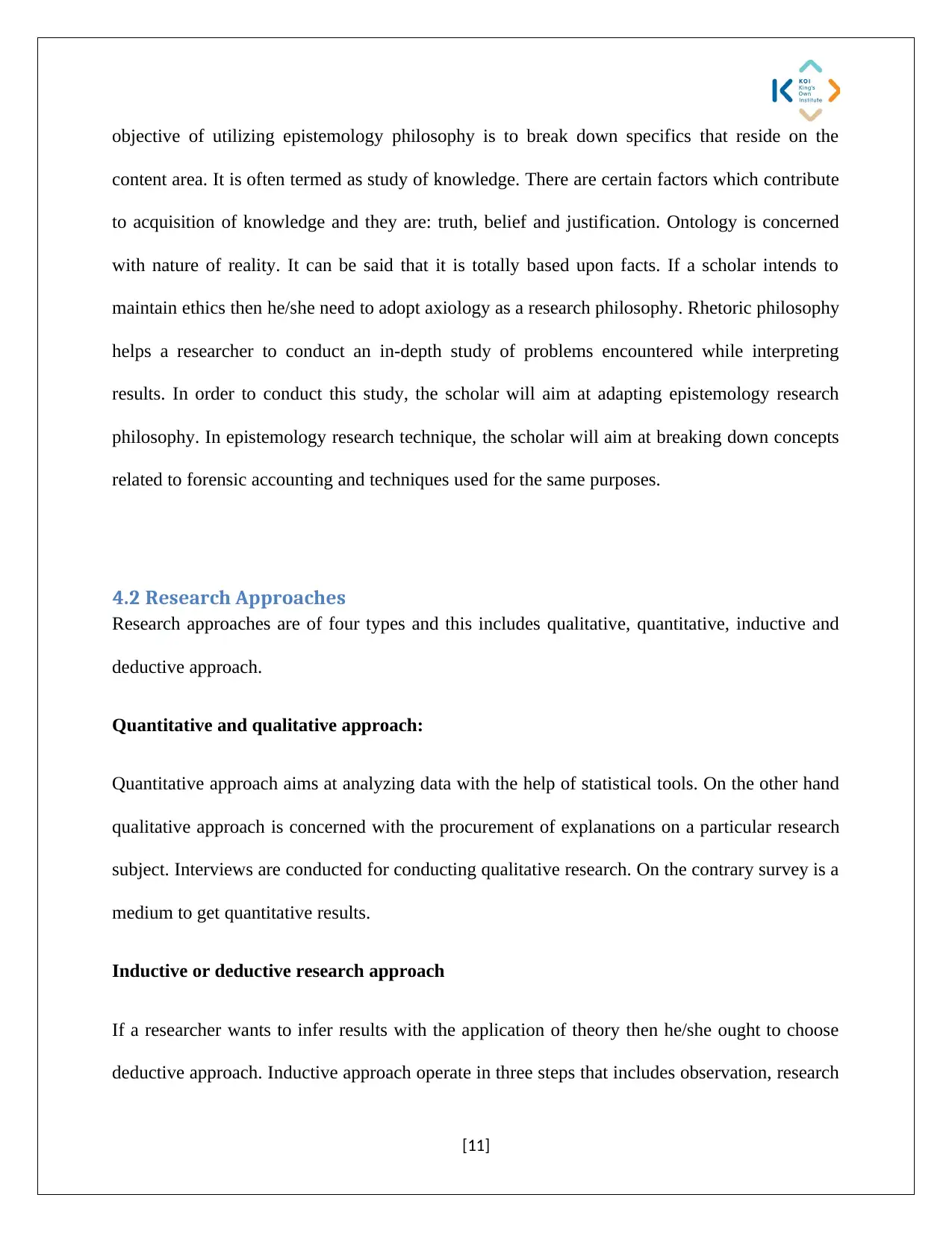
objective of utilizing epistemology philosophy is to break down specifics that reside on the
content area. It is often termed as study of knowledge. There are certain factors which contribute
to acquisition of knowledge and they are: truth, belief and justification. Ontology is concerned
with nature of reality. It can be said that it is totally based upon facts. If a scholar intends to
maintain ethics then he/she need to adopt axiology as a research philosophy. Rhetoric philosophy
helps a researcher to conduct an in-depth study of problems encountered while interpreting
results. In order to conduct this study, the scholar will aim at adapting epistemology research
philosophy. In epistemology research technique, the scholar will aim at breaking down concepts
related to forensic accounting and techniques used for the same purposes.
4.2 Research Approaches
Research approaches are of four types and this includes qualitative, quantitative, inductive and
deductive approach.
Quantitative and qualitative approach:
Quantitative approach aims at analyzing data with the help of statistical tools. On the other hand
qualitative approach is concerned with the procurement of explanations on a particular research
subject. Interviews are conducted for conducting qualitative research. On the contrary survey is a
medium to get quantitative results.
Inductive or deductive research approach
If a researcher wants to infer results with the application of theory then he/she ought to choose
deductive approach. Inductive approach operate in three steps that includes observation, research
[11]
content area. It is often termed as study of knowledge. There are certain factors which contribute
to acquisition of knowledge and they are: truth, belief and justification. Ontology is concerned
with nature of reality. It can be said that it is totally based upon facts. If a scholar intends to
maintain ethics then he/she need to adopt axiology as a research philosophy. Rhetoric philosophy
helps a researcher to conduct an in-depth study of problems encountered while interpreting
results. In order to conduct this study, the scholar will aim at adapting epistemology research
philosophy. In epistemology research technique, the scholar will aim at breaking down concepts
related to forensic accounting and techniques used for the same purposes.
4.2 Research Approaches
Research approaches are of four types and this includes qualitative, quantitative, inductive and
deductive approach.
Quantitative and qualitative approach:
Quantitative approach aims at analyzing data with the help of statistical tools. On the other hand
qualitative approach is concerned with the procurement of explanations on a particular research
subject. Interviews are conducted for conducting qualitative research. On the contrary survey is a
medium to get quantitative results.
Inductive or deductive research approach
If a researcher wants to infer results with the application of theory then he/she ought to choose
deductive approach. Inductive approach operate in three steps that includes observation, research
[11]
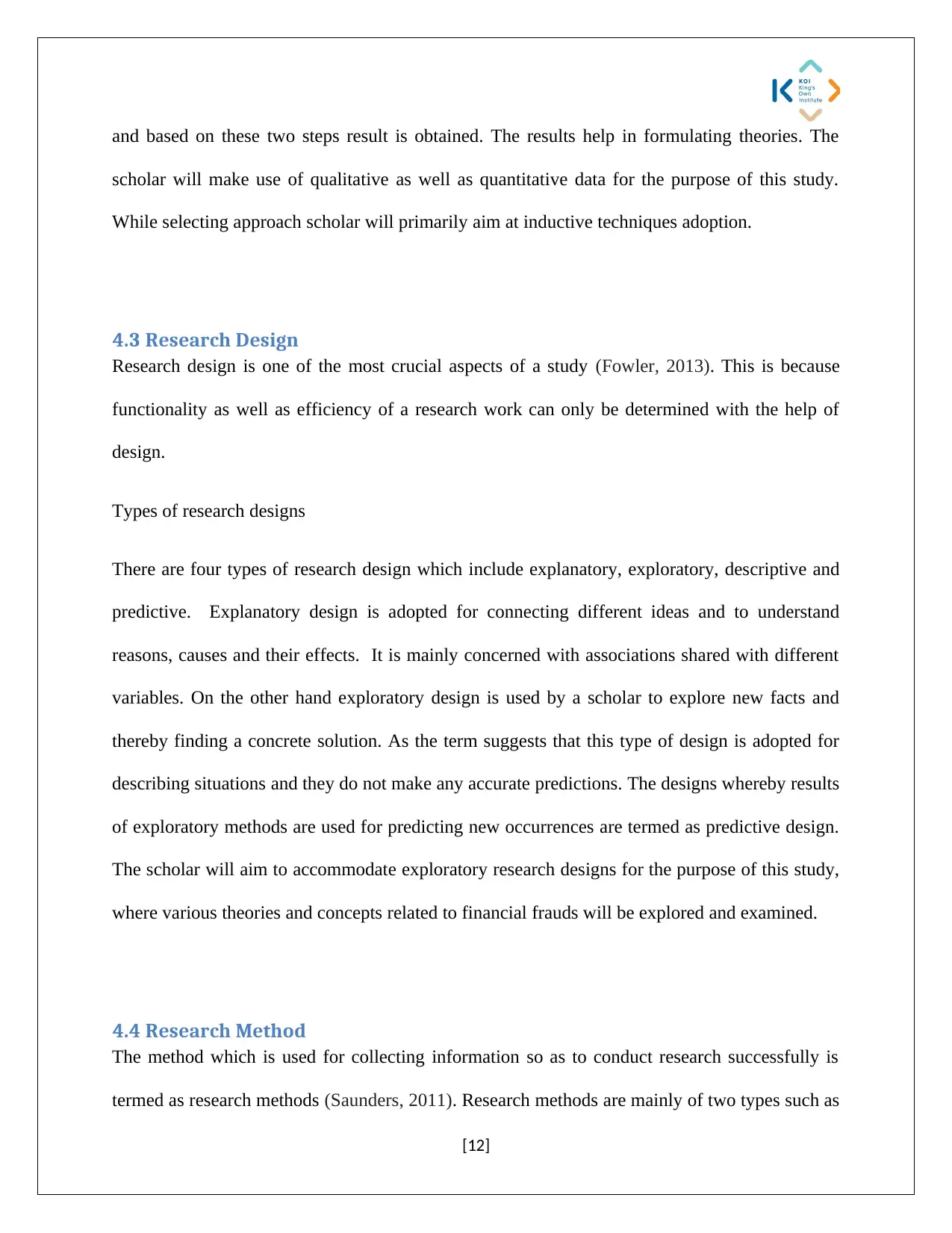
and based on these two steps result is obtained. The results help in formulating theories. The
scholar will make use of qualitative as well as quantitative data for the purpose of this study.
While selecting approach scholar will primarily aim at inductive techniques adoption.
4.3 Research Design
Research design is one of the most crucial aspects of a study (Fowler, 2013). This is because
functionality as well as efficiency of a research work can only be determined with the help of
design.
Types of research designs
There are four types of research design which include explanatory, exploratory, descriptive and
predictive. Explanatory design is adopted for connecting different ideas and to understand
reasons, causes and their effects. It is mainly concerned with associations shared with different
variables. On the other hand exploratory design is used by a scholar to explore new facts and
thereby finding a concrete solution. As the term suggests that this type of design is adopted for
describing situations and they do not make any accurate predictions. The designs whereby results
of exploratory methods are used for predicting new occurrences are termed as predictive design.
The scholar will aim to accommodate exploratory research designs for the purpose of this study,
where various theories and concepts related to financial frauds will be explored and examined.
4.4 Research Method
The method which is used for collecting information so as to conduct research successfully is
termed as research methods (Saunders, 2011). Research methods are mainly of two types such as
[12]
scholar will make use of qualitative as well as quantitative data for the purpose of this study.
While selecting approach scholar will primarily aim at inductive techniques adoption.
4.3 Research Design
Research design is one of the most crucial aspects of a study (Fowler, 2013). This is because
functionality as well as efficiency of a research work can only be determined with the help of
design.
Types of research designs
There are four types of research design which include explanatory, exploratory, descriptive and
predictive. Explanatory design is adopted for connecting different ideas and to understand
reasons, causes and their effects. It is mainly concerned with associations shared with different
variables. On the other hand exploratory design is used by a scholar to explore new facts and
thereby finding a concrete solution. As the term suggests that this type of design is adopted for
describing situations and they do not make any accurate predictions. The designs whereby results
of exploratory methods are used for predicting new occurrences are termed as predictive design.
The scholar will aim to accommodate exploratory research designs for the purpose of this study,
where various theories and concepts related to financial frauds will be explored and examined.
4.4 Research Method
The method which is used for collecting information so as to conduct research successfully is
termed as research methods (Saunders, 2011). Research methods are mainly of two types such as
[12]
⊘ This is a preview!⊘
Do you want full access?
Subscribe today to unlock all pages.

Trusted by 1+ million students worldwide
1 out of 20
Related Documents
Your All-in-One AI-Powered Toolkit for Academic Success.
+13062052269
info@desklib.com
Available 24*7 on WhatsApp / Email
![[object Object]](/_next/static/media/star-bottom.7253800d.svg)
Unlock your academic potential
Copyright © 2020–2025 A2Z Services. All Rights Reserved. Developed and managed by ZUCOL.




